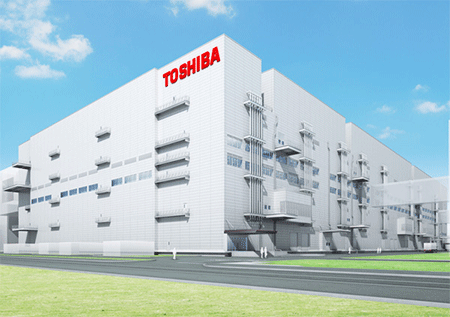In their pursuit of thinner and lighter chips, Toshiba Corporation and SanDisk Corporation — a global leader in flash storage solutions — have announced that they plan to start production of a new and advanced type of flash memory chips at a plant in Japan, which will begin in 2016.

Image credit: www.toshiba.com
NAND memory chips are used in smart-phones, cameras and other mobile devices to store music, pictures and other data. The new and advanced 3D NAND technology can store 16 times more than any other existing products.
According to the press release by Toshiba, both companies have entered into a non-binding memorandum of understanding, without revealing the amount of the investment.
Sources say that both Toshiba and California-based SanDisk will split the cost and invest up to 500 billion yen ($4.9 billion) in the new facility in Japan.
The new factory will be built on the site of the demolished No. 2 semiconductor fabrication facility (Fab 2) at Yokkaichi Operations, the company’s NAND Flash memory plant in Mie prefecture.
The construction of the new factory will begin in September 2014, while the old factory is set to be demolished this month.
“Our determination to develop advanced technologies underlines our commitment to respond to continued demand of NAND flash memory. We are confident that our joint venture with SanDisk will allow us to produce cost competitive next generation memories at Yokkaichi,” said Yasuo Naruke, Corporate Senior Vice President of Toshiba Corporation and President and CEO of Semiconductor & Storage Products Company.
“We are pleased to continue our long-standing collaboration with Toshiba in this new wafer fab, which will advance our leadership in memory technology into the 3D NAND era,” said Sanjay Mehrotra, President and Chief Executive Officer of SanDisk Corporation.
The new factory will be environmentally friendly with LED lighting and top-notch energy-saving manufacturing equipment to reduce energy consumption and increase productivity.
Reducing the size of NAND cells for smart-phones and other mobile devices has been a top priority for chip makers, with NAND memory chips expected to account for 5.2% of total memory shipments this year, reports the Wall Street Journal.
Research firm IHS reveals this portion will see a dramatic expansion to 30.2% in 2015.
For more information about Toshiba go to www.toshiba.com
For more information about SanDisk, go to www.sandisk.com




















